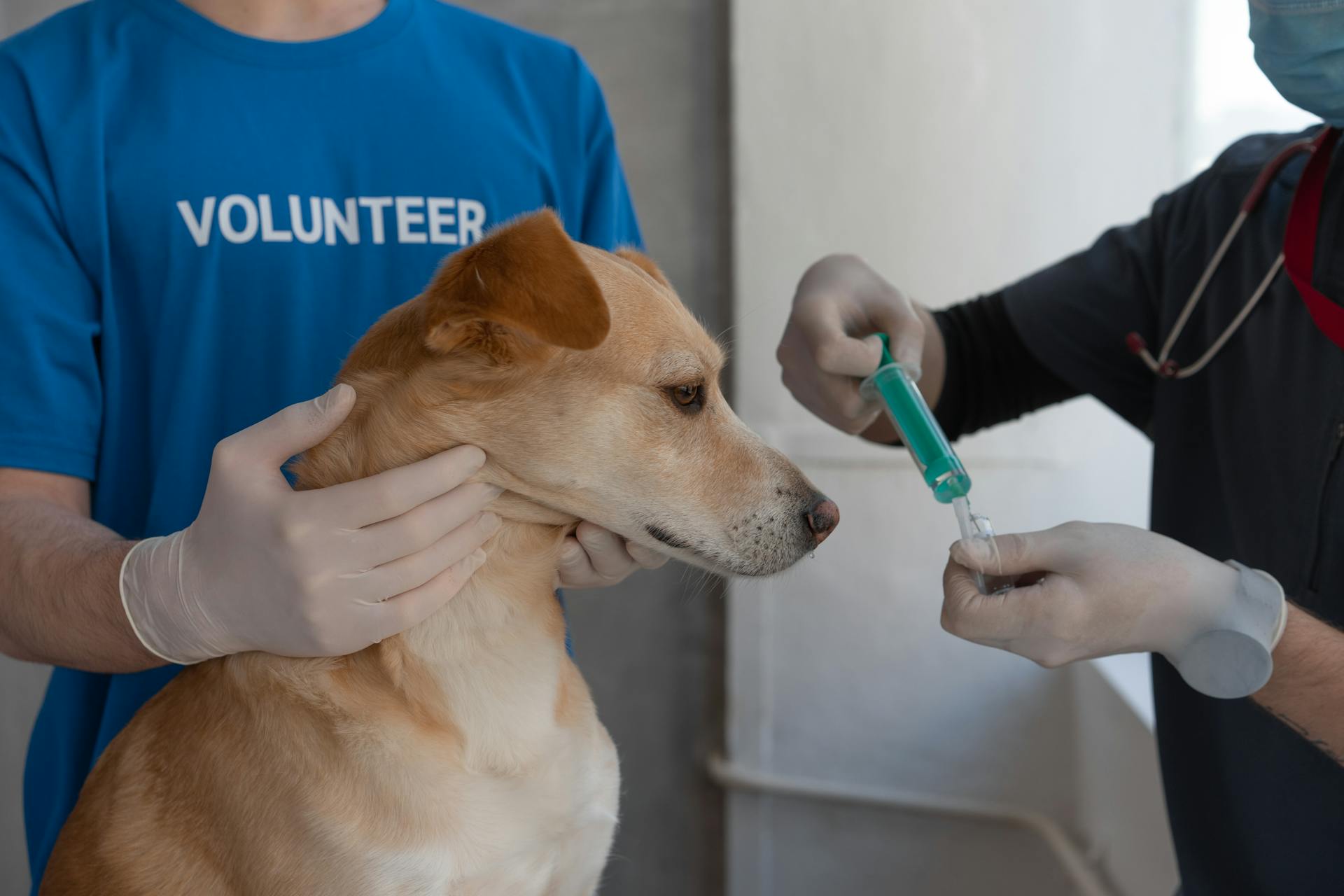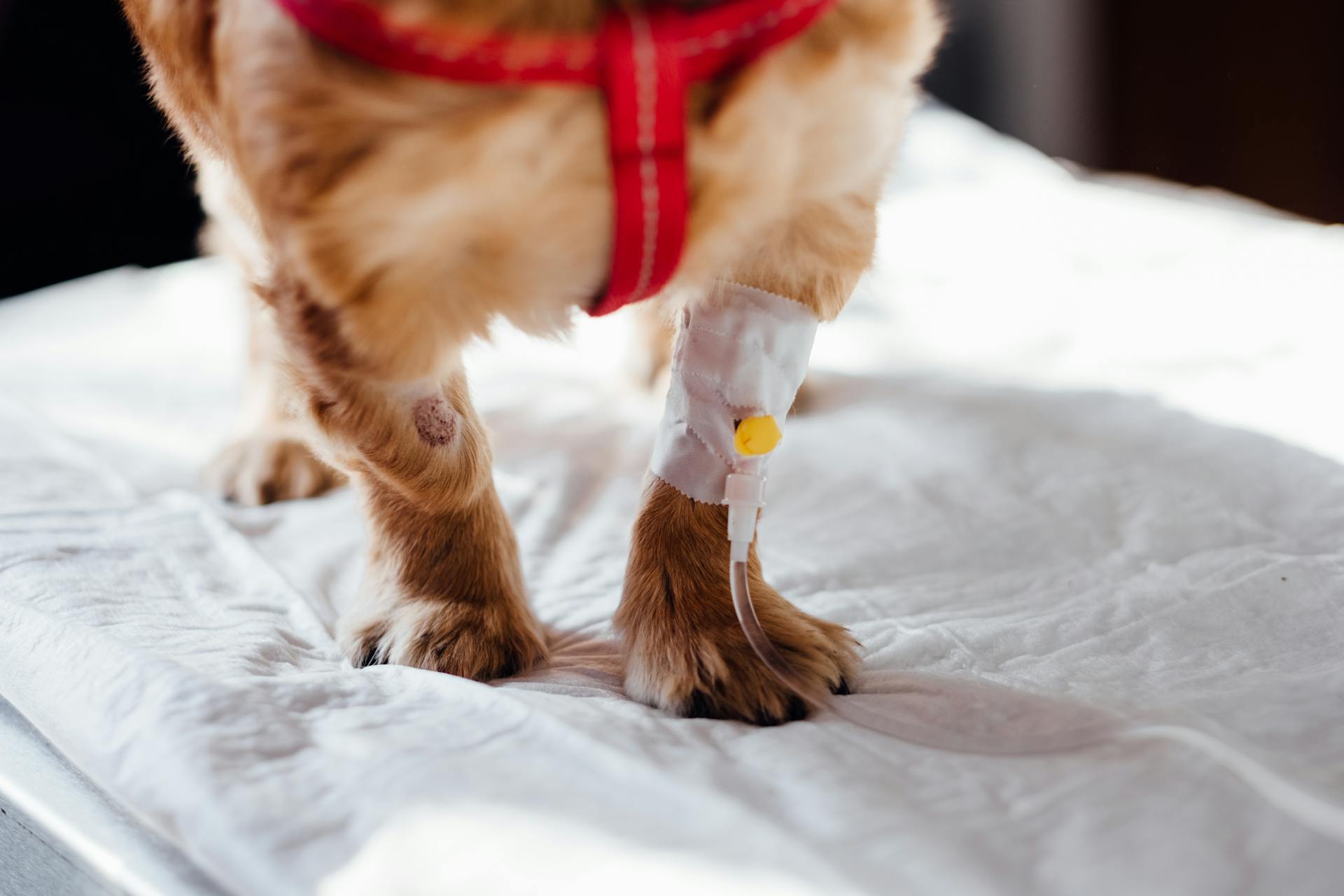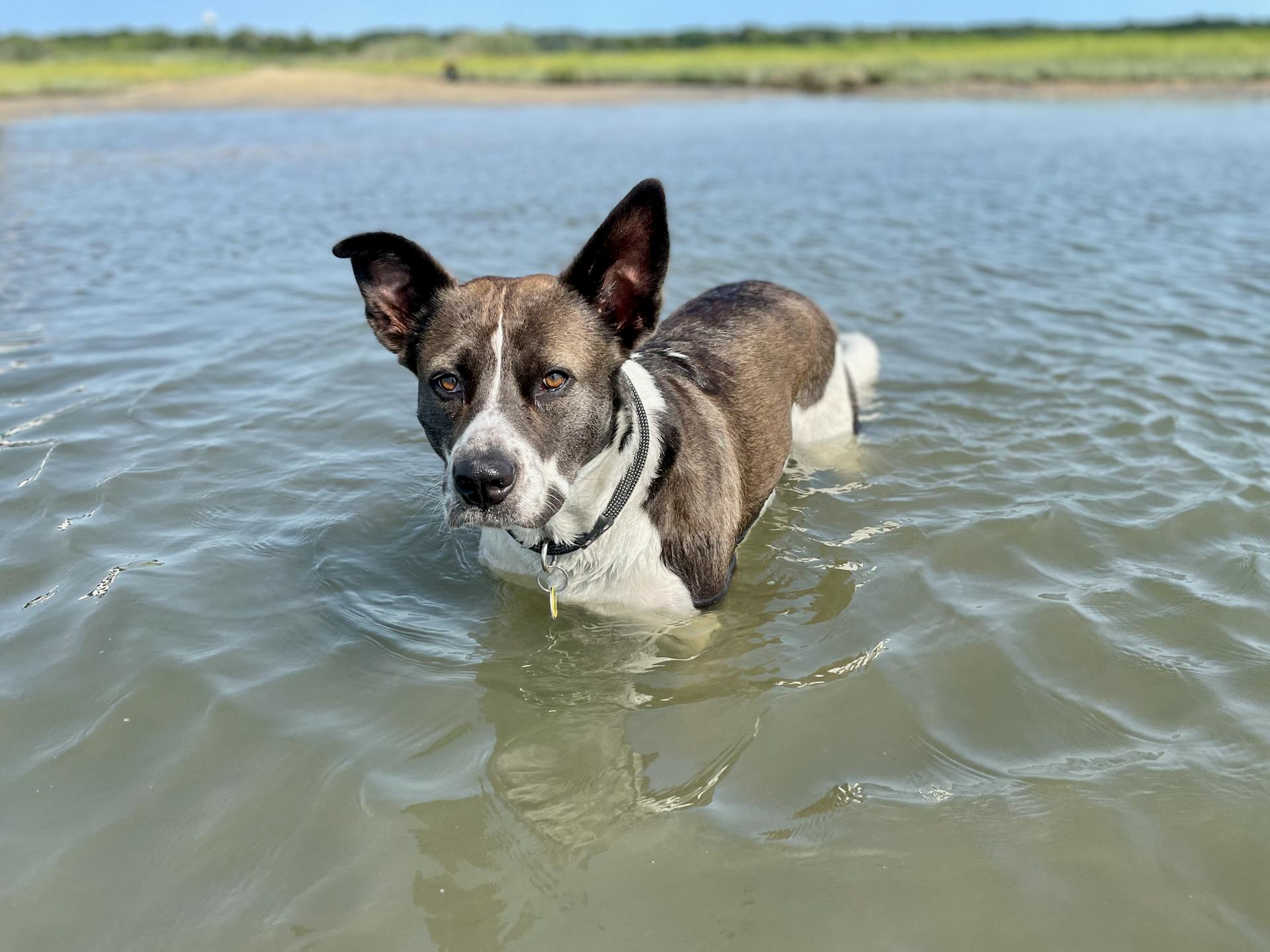
Canine parvovirus can have long-lasting effects on a dog's health and well-being. Some dogs may experience chronic gastrointestinal issues, such as diarrhea and vomiting, for months after initially contracting the virus.
In severe cases, dogs may develop secondary infections, like pneumonia or sepsis, which can be life-threatening. These secondary infections can occur due to the virus weakening the dog's immune system.
Dogs that recover from parvovirus may still experience long-term effects, including a weakened immune system, making them more susceptible to future illnesses. Some dogs may also develop chronic conditions, such as arthritis or heart disease, as a result of the virus.
Consider reading: Puppy Strangles Long Term Effects
Symptoms and Effects
Canine parvovirus can have severe and long-lasting effects on a dog's health.
The virus attacks the intestinal lining, causing a thickened and discolored intestinal wall, watery, mucoid, or hemorrhagic intestinal contents, and edema and congestion of abdominal and thoracic lymph nodes.
In severe cases, the virus can also cause thymic atrophy and pale streaks in the myocardium due to myocarditis.
Here's an interesting read: Canine Distemper Virus
Histologically, intestinal lesions are characterized by multifocal necrosis of the crypt epithelium, loss of crypt architecture, and villous blunting and sloughing.
This can lead to a range of secondary complications, including pulmonary edema, alveolitis, and bacterial colonization of the lungs and liver.
Here are some of the specific effects of canine parvovirus on a dog's body:
- Depletion of lymphoid tissue and cortical lymphocytes (Peyer's patches, peripheral lymph nodes, mesenteric lymph nodes, thymus, spleen)
- Bone marrow hypoplasia
Diagnosis and Treatment
The diagnosis of canine parvovirus is typically made through a combination of physical examination, medical history, and laboratory tests.
A veterinarian will usually perform a physical examination to look for signs of dehydration, weight loss, and abdominal pain.
Laboratory tests such as fecal exams and blood tests can help confirm the presence of the virus.
In severe cases, a veterinarian may perform an abdominal X-ray to check for intestinal obstruction or perforation.
Treatment for canine parvovirus typically involves hospitalization, fluid therapy, and antibiotics to prevent secondary infections.
Supportive care such as feeding through an intravenous tube and administering medication to control vomiting may also be necessary.
The goal of treatment is to manage symptoms, prevent complications, and support the dog's recovery.
In some cases, a veterinarian may recommend a specific diet or nutritional supplements to help support the dog's recovery.
With proper treatment and care, most dogs can recover from canine parvovirus, but the disease can have long-term effects on the dog's health.
Expand your knowledge: Lick Granuloma Dog Home Treatment
Prevention and Control
Prevention and control of canine parvovirus are crucial to minimize its impact.
Dogs with confirmed or suspected CPV enteritis must be handled with strict isolation procedures, including isolation housing, gowning and gloving of personnel, and frequent and thorough cleaning.
Frequent and thorough cleaning is essential to limit environmental contamination.
Surfaces should be cleaned of gross organic matter and then disinfected with a solution of dilute bleach or a peroxygen disinfectant.
Inactivated rather than modified-live vaccines are indicated in pregnant dogs or colostrum-deprived puppies vaccinated before 6-8 weeks of age.
Current modified-live CPV vaccines are sufficiently immunogenic to protect puppies from infection in the presence of low levels of interfering maternal antibody.
You might enjoy: Canine Distemper Symptoms in Puppies
Vaccination of 4-week-old puppies with a high antigen titer vaccine results in seroconversion and may decrease the window of susceptibility to infection.
Cages and equipment should be cleaned, disinfected, and dried twice before reuse in a kennel, shelter, or hospital situation.
In a home situation, only fully vaccinated puppies (at 6, 8, and 12 weeks) or fully vaccinated adult dogs should be introduced into the home of a dog recently diagnosed with CPV enteritis.
Broaden your view: Kennel Cough over the Counter Meds
Understanding the Disease
Canine parvovirus, also known as parvo, is a highly contagious and potentially life-threatening disease that affects dogs of all ages.
The virus attacks the dog's gastrointestinal tract and immune system, causing severe vomiting and diarrhea that can lead to dehydration and electrolyte imbalances.
Symptoms can appear anywhere from 3 to 14 days after exposure, and if left untreated, the virus can cause damage to the heart, which can lead to long-term effects.
The severity of the disease depends on the dog's age, health status, and the presence of any underlying medical conditions.
A fresh viewpoint: Dog Lead Extra Long
Why Might My Dog Become Infected?

Canine parvovirus can be found in almost any environment, so it's essential to take precautions to protect your furry friend.
The immune status of your dog plays a significant role in determining whether they'll become infected. If your dog's immune system is weakened, they're more susceptible to the virus.
Several factors come into play when a dog is exposed to the virus, including the number of viruses they're exposed to. This is why even if your dog is exposed to the virus, they may not become infected if the number of viruses is low.
A dog's likelihood of becoming infected increases if they're exposed to a large number of viruses. This is why it's crucial to take steps to prevent exposure in the first place.
Here's an interesting read: Do Dogs Catch Human Viruses
Etiology and Pathophysiology
Canine parvovirus (CPV) is a highly contagious and relatively common cause of acute, infectious GI illness in young and/or unvaccinated dogs. It's a nonenveloped, single-stranded DNA virus that's resistant to many common detergents and disinfectants.
Readers also liked: Most Common Dog Diseases
CPV can persist indoors at room temperature for at least 2 months, and outdoors, if protected from sunlight and desiccation, it can persist for many months and possibly years. This means that even if you think you've cleaned up a contaminated area, the virus could still be lurking.
In North America, clinical disease is largely attributed to CPV-2b, but a newer and equally virulent strain, CPV-2c, is increasingly common, having been identified in at least 15 states.
Young dogs, typically between 6 weeks to 6 months old, are most susceptible to CPV infection. This is because their immune systems are still developing and they haven't had a chance to receive full vaccinations.
Some breeds are described as being at increased risk, including Rottweilers, Doberman Pinschers, American Pit Bull Terriers, English Springer Spaniels, and German Shepherds.
Here are some breeds that are at increased risk of CPV infection:
- Rottweilers
- Doberman Pinschers
- American Pit Bull Terriers
- English Springer Spaniels
- German Shepherds
Assuming sufficient colostrum ingestion, puppies born to a dam with CPV antibodies are protected from infection for the first few weeks of life. However, this protection wears off as the maternal antibodies wane, leaving the puppy susceptible to infection.
Stress, such as weaning, overcrowding, malnutrition, or concurrent intestinal parasitism, can make a dog more likely to develop severe clinical illness if infected with CPV.
Sources
- https://pubmed.ncbi.nlm.nih.gov/29547647/
- https://www.webmd.com/pets/dogs/what-is-parvovirus
- https://www.vet.cornell.edu/departments-centers-and-institutes/baker-institute/research-baker-institute/canine-parvovirus
- https://www.merckvetmanual.com/digestive-system/diseases-of-the-stomach-and-intestines-in-small-animals/canine-parvovirus
- https://vcahospitals.com/know-your-pet/parvovirus-in-dogs
Featured Images: pexels.com


